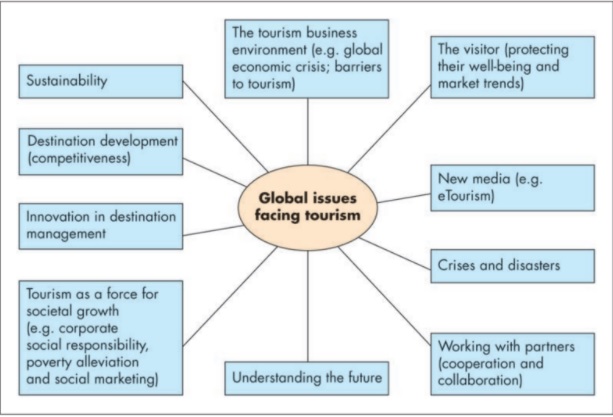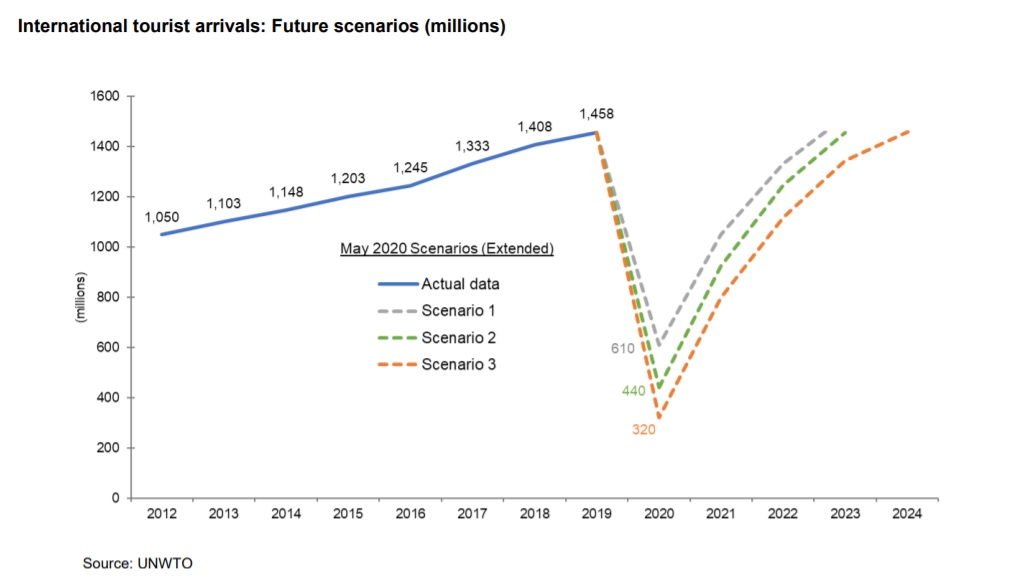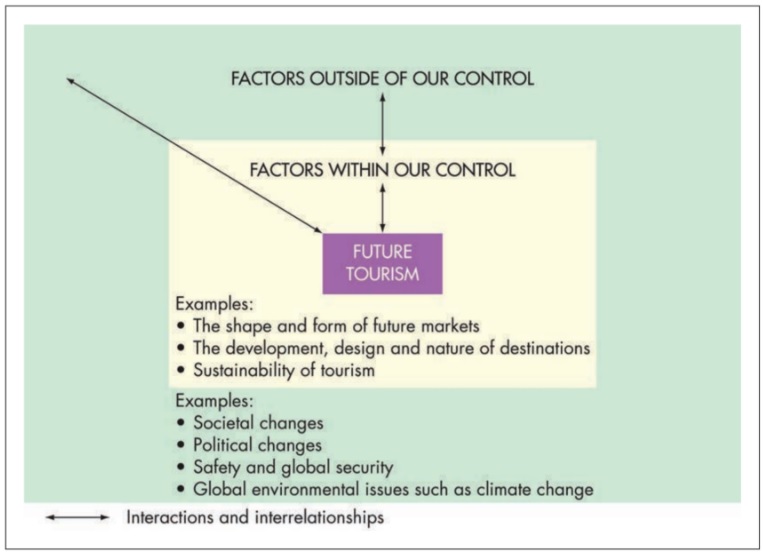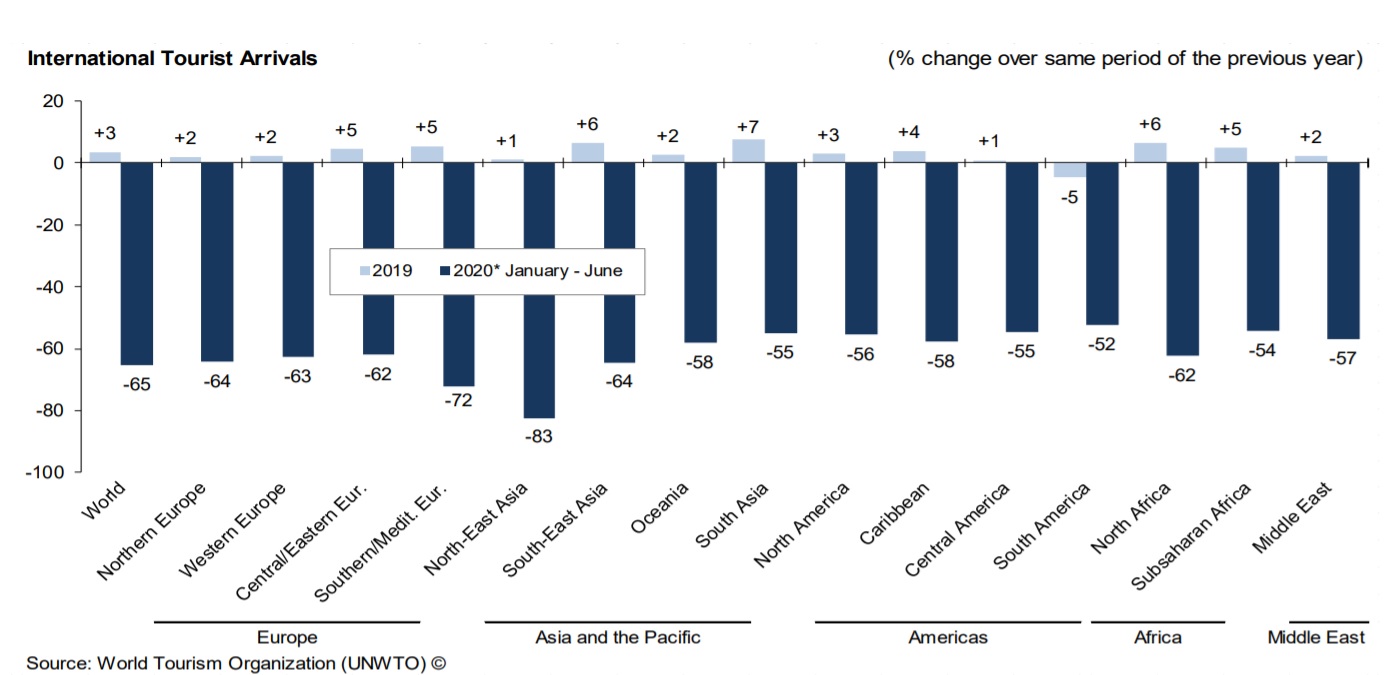Understanding Modern Tourism Industry
Within a fast-growing, technology-based society, the majority of leading industries aim to keep up with the latest changes to achieve stable progress. Tourism is generally considered one of the most prosperous business domains, which faced critical challenges over the past year. The dramatic spread of COVID-19 has shaped a new way of building tourism and its underlying structure and made it a fragile industry until nowadays. In this research, tourism will be examined in the context of current trends affecting the industry, characteristics of tourist destinations, and evaluation of these aspects on the international level and their impact on one another.
The Current Trends Affecting National and International Tourist Destinations
The tourism industry and trends shaping its contemporary image in terms of a global business scene are primarily influenced by a wide range of factors, which are external to tourism and beyond its regulation. More specifically, the impact of tourism can be examined in association with various resources and environments consumed by the industry itself (Fig. 1). The most recent tourism and hospitality trends encompass e-tourism, new management approaches, and new supply and demand elements, including low-cost airlines and growth in independent travel (Page and Connell, 2020). The current trends in the travel sector should be regarded according to the division of the urban, rural, coastal, and resort tourism fields, as well as the hospitality industry in the least developing countries. This significantly affects the different types of tourist destinations and how it affects the national economies worldwide.

The Analysis of the Main Tourist Destinations of the World
The main tourist destinations are primarily shaped by the patterns of global investment flows, which create the universal forms of travel and tourism production, including hotel chains and integrated hospitality enterprises. However, the dynamic flow of traveling currently extends to all parts of the globe, thus, intensifies activity at particular locations. According to Page and Connell (2020), such an international investment movement defined the leading role of the world tourism destinations, such as “London, Paris, New York, and Rome” (p. 17). Moreover, these cities own global control over capital flows. In the same way, travel activity is reinforcing within three central regions that govern international patterns, including Europe, North America, and East Asia-Pacific.
From the quantitative perspective, the top ten tourist destinations include France, Spain, the United States, China, Italy, Turkey, Mexico, Thailand, Germany, and the United Kingdom, ranging from 83.5 million to 39.4 million tourist arrivals accordingly. Based on the income generation, the most popular travel locations imply the following order: United States, Spain, France, Thailand, United Kingdom, Italy, Australia, Germany, Japan, and China (CITE). Most importantly, the latter ratio is developed in relation to the percentage of GDP (Gross Domestic Product), impacting the economic growth of the countries. The highest increase in GDP is traced in Thailand (12.6 %) and Spain (5.2 %) (CITE). Nonetheless, the United States obtains the highest total tourism income with over 210 billion $ annually.
The Assessment of the Current Trends Affecting Tourist Destinations
Currents trends affecting pivotal tourist destinations are mainly based on the globalization process. Such a critical process has the power to connect the diversified cultures on the international level, emphasizing inequities and the gap between the developed and developing nations. Therefore, these two major global destinations are based on cultural contact and the international capital, utilizing tourism destinations. It is important to consider that local communities and resource endowments are built to profit from the tourism activity. However, compared to the global leaders in hospitality, the less developed destinations face the reinforced inequalities. In addition, the spread of the world pandemic severely restricted the opportunities of the current tourism industry and altered the modern trends, which significantly impact the future of the travel domain.
The main current tourism trends include leisure travel, increased automation service, mobile bookings, personalization, sustainability and eco-travel, transformation, experience and solo journey, and safety and hygiene approach to travel. Moreover, the modern tendencies affecting tourist destinations encompass both travelers and market trends. According to Kozak and Baloglu (2012), the first aspect refers to more educated tourists, enhanced personal mobility, attitude towards cultural diversity, demand for individualized experience, and technology-oriented customers. The second aspect incorporates increased tourism marketing responsibility, emphasis on disaster and crisis planning, higher-speed transportation, and tourism diversification.
The Analysis of the Future Trends in Tourist Destinations
The number of tourists within the modern travel industry represents only one of the several determining features of the future of a changing tourism landscape. Ryan (2018) states that tourist trade today entails “a virtual space” that defines current perceptions and expectations regarding tourist destinations (p. 197). Also, such a space guides the consumers to particular locations and disseminates the appraisals regardless of more conventional modes of promotion, given the industry’s perspective. Therefore, the current potential of virtual and extended reality in the near future shapes one of the future trends in tourist destinations, including the use of advanced technologies and artificial intelligence. Such a tech-savvy approach will considerably continue to define the essential practices and behaviors in the travel sector.

Despite the external factors influencing the tourism industry, which are beyond one’s control, several tourism-related factors affect the future trends in this sector. Such a system serves as a groundwork for two underlying considerations, including exogenous factors and those within the control and factors outside the management (Fig. 3). As claimed in the table below, the future trends in travel and hospitality are based on critical societal and political changes, as well as safety and global security. Future trends also embrace the vital approaches towards combatting global environmental issues, including climate change and health challenges, such as the COVID-19 pandemic (Fig. 4). Most importantly, tourist destinations must develop environmentally-friendly policies to preserve their competitive advantage on a high level within a future marketplace.


The Characteristics of Tourist Destinations and the Relationship to their Appeal
The market appeal of tourist destinations can be examined at a geographic level, wherein they can attract visitors at a local market, regionally, nationally, or even internationally. Some of the main attractions appeal to a particular group of tourists based on the demographic level (Page and Connell, 2020). For instance, Disneyland is a global tourist destination point; however, it is more oriented to younger families with children and sometimes older people. At the same time, Universal Studios is a movie-targeted place attracting universal age groups. Apart from providing appeal in a particular destination, tourist attractions serve as the focal points for increased consumer activity and money spending. It is specifically important when the tourism forms are part of the comprehensive development strategy or area restoration approach. As a result, the salient characteristics of the tourist destinations reinforce the place’s appeal to the visitors and, thus, eliminates poverty in a particular region.
The Cultural, Social, and Physical Characteristics of Tourist Destinations
The European and worldwide tourist destinations remain the leading actors in the travel sector with a new tourist attraction introduced annually, obtaining a strong, appealing factor. Moreover, it is a general approach to advertising key tourist destinations via social media networks. Some of the most advertised destinations over the past years include “Turkey, Brazil, China, and India” (Chin, Lo, Razak, Pasbakhsh, and Mohamad, 2020, p. 3). When evaluating how the characteristics of a leading tourist destination affect its appeal, several factors need to be considered. In general, tourists select one destination over another for a particular reason based on cultural appeal, the destination’s characteristics and attractions, and the ability to access the area. Chin et al. (2020) highlight the key features that affect the appeal of the tourist destination, including “infant mortality, life expectancy, level of poverty, and migration from rural to urban” (p. 10). With this said, the destination appeals and tourism infrastructure represent a physical product as they both are capable of providing physical satisfaction to the area’s visitors.
It is important to note that the concept of destination appeal has faced an increased interest in rural tourism in the modern travel industry. The reason for such transformation is that it can facilitate the destination’s attractiveness and engage more tourist visits. The destination appeals are commonly associated with the people (social factor), food, history, and culture (cultural factor), as well as climatic conditions, landscape features, and tourism-related activities (physical factor) (Chin et al., 2020). Such factors comprising natural resources, cultural heritage, and outdoor activities play a leading role in defining the influence on the appealing aspects to captivate increased level of visitors to tourist destinations.
The cultural factors impacting tourist attractions’ appeal include local religion and beliefs, food and drink, art heritage, historical sites, language, and main cultural events. Altogether, they represent the cultural richness of the region and define the choices of tourists’ appeal. For instance, the United Kingdom, France, and Spain are known for their abundant ethnic foundation; thereby, they attract visitors with the help of museums, libraries, historical monuments, and cultural events to reinforce the cultural inheritance of the destinations (Page and Connell, 2020). According to Joshi, Poudyal, and Larson (2016), it is essential to preserve such cultural resources within the unique natural environment, specifically among exotic cultures, to maintain authenticity and appeal to tourist destinations.
The social characteristics of the travel destinations and places involve the core social culture customs and safety measures of the country, city, or a small rural destination, unique for each tourist attraction. The physical factors comprise climate, natural environment, and ecology that serve the visitors’ preferences and tastes during travel (Page and Connell, 2020). The physical beauty of the tourist destination implies the collection of its cities, natural green and water resources, and rural sites. Concerning the effect of such characteristics on the tourist destination appeal, each country presents its leading position in the particular sector. For example, the United Kingdom is significantly impacted by its cultural characteristics due to the prevailing culture and tradition in this region that attract tourists worldwide.
Instead, France is led by its physical characteristics, namely geographical factors, such as islands, rivers, mountains, flatbeds, and forests. More specifically, Alps Mountain is a unique tourist destination with an increased appeal annually (Page and Connell, 2020). Spain, in turn, attracts its visitors through social features, including national and religious social groups. However, some characteristics might also have an opposite effect, including countries with the enhanced level of terrorism, violence, crime, and unreliable local law enforcement, undermining tourists’ safety and health. In addition, the over-commercialized tourist destinations can cause crowded spaces and rapid increase and abundance of the urban infrastructure, which has to be regulated by the authorities.
The Characteristics of Tourist Destinations and their Impact on Tourist and Tourism
According to the current research, tourist destinations obtain particular social, physical, and cultural characteristics that affect the international tourism sector differently. All the factors comprise both positive and negative impacts on the tourist attractions and, therefore, the travel domain in the specific country in general. Given that tourism is an integral part of economies in developed and developing countries, the industry contributes approximately nine percent of the global domestic product (GDP) (Joshi et al., 2016). As such, touristry became a highly competitive business and economic sector in a global arena led by globalization. Moreover, the industry is characterized by complex dynamics, meaning that it is extremely vulnerable to political, socioeconomic, and environmental change. Such aspects define the tourists’ preferences and choices of tourist destinations, impacting the tourism domain on the international level.
The Characteristics of a Developing Tourist Destination
It is essential to examine the complex characteristics of tourist destinations to understand its correlation with tourist behavior and tourism that promotes sustainable tourism development on a global level. Szromek (2019) described that tourist destinations address “various environmental and sociocultural impacts” throughout the development stage (p. 5). There is a particular set of characteristics that define certain stages of development of a tourist area. Such features are united into major groups, including “destination characteristics, marketing response, economic impact, social impact, and environmental impact” (Szromek, 2019, p. 5). More specifically, the developing tourist attractions are currently characterized by the rapid advancement in modern technologies. Therefore, developing destinations are defined by technological infrastructure, sustainable development, universal accessibility, tourist interaction with the environment, and quality experience.
The current research also defines the particular factors impacting the international tourist numbers and their selection patterns regarding specific tourist destinations. With this said, Joshi et al. (2016) analyze the factors related to policies and governmental regulation; the socioeconomic context; business, facilities, and tourism infrastructure; and aspects of natural and cultural resources. Destination characteristics define the individual development phases of tourism, including “number of visitors, growth rate, the capacity of beds, occupancy rate, service prices, expenses per person, visitor type, brand and attractiveness” (Szromek, 2019, p. 7). The main characteristics of tourist destinations also imply international receipts, policy, environment preservation, safety and security, health and hygiene, price competitiveness, human resources and affinity, infrastructure, and natural and cultural endowments. Another critical characteristic of tourist attractions implies the relationship between national policy and international tourism receipts. The existing domestic regulations should prioritize travel and tourism to generate enhanced tourism revenue.
The Impact of a Tourist Destination’s Characteristics on its Appeal to Tourists
Tourism primarily relies upon a positive tourism experience, which requires concurrent positive outcomes from the physical, geographical, and sociocultural factors concerning tourist destination and society. Hence, the travel industry’s sustainable and robust development is maintained by the quality and delivery of service, hospitality, and the diversity and availability of choices for tourists. According to econometric studies, tourism demand is directly dependent on “tourist income, the relative price of tourism product in destination versus the country of origin, substitution effects, and the exchange rate” (Joshi et al., 2016, p. 833). Furthermore, the above-mentioned international receipts factor mainly reflects the duration of tourists’ stay and their financial input to the tourist destination. In a similar way, tourists decide to select the commodity that delivers the maximum level of utility and satisfaction compared to other available alternatives.
It can be argued that the core of tourists’ rational choices and decisions within the travel process is mainly concentrated on the highest satisfaction that the tourist destination can provide. Also, each tourist is searching for a unique travel experience according to their individual demands and tourism goals. This facilitates a variable that differs substantially from country to country. The well-developed national policies considerably impact the international image of the destination and, thus, attract an increased number of tourists and associated revenue. However, the most fundamental concern in the modern travel industry is based on the rapidly growing demand for experiences within unique natural environments or among exotic cultures. As such, the competitive side of each tourist destination is significantly affected by its capacity to provide extraordinary tourist experience, intensity, and diversity, which will continue to affect the destination’s appeal to tourists in the future.
Conclusion
Touristry remains the most demanded concern for modern society as it enables crucial worldwide connections and helps people discover the world. Its position in a global arena is defined by the current and future trends, the relationship between tourist destination and their appeal, and how the destination’s characteristics impact tourists and tourism in general. Summing up, tourism is a global phenomenon addressing rapid development and growth in both developed countries and newly emerging economies. The enhanced understanding of tourism demand and tourists themselves as consumers is crucial to reinforce and maintain stable progress of the industry despite the critical challenges and crises in other domains.
References
Chin, C. H., Lo, M. C., Razak, Z., Pasbakhsh, P., & Mohamad, A. A. (2020). Resources confirmation for tourism destinations marketing efforts using PLS-MGA: The moderating impact of semirural and rural tourism destination. Sustainability, 12(17), 1–23.
Joshi, O., Poudyal, N. C., & Larson, L. R. (2016). The influence of sociopolitical, natural, and cultural factors on international tourism growth: a cross-country panel analysis. Environment, Development and Sustainability, 19(3), 825–838. Web.
Kozak, M, & Baloglu, S. (2012). Managing and marketing tourist destinations: Strategies to gain a competitive edge. Routledge.
Page, S. J., & Connell, J. (2020). Tourism: A modern synthesis. Routledge.
Ryan, C. (2018). Future trends in tourism research – Looking back to look forward: The future of “Tourism Management Perspectives.” Tourism Management Perspectives, 25, 196–199. Web.
Szromek, A. (2019). An analytical model of tourist destination development and characteristics of the development stages: Example of the island of Bornholm. Sustainability, 11, 6989.
UNWTO (2020). World tourism barometer. World Tourism Organization, 18(5), 1–24.